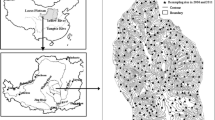Abstract
Based on climate material, the simplified terrestrial carbon cycle balance (TCCB) model was established, which is semi-mechanism and semi-statistics. Through TCCB model, our estimate indicates that the southeastern part of the Tibetan Plateau has much higher carbon content, and we have calculated the litter carbon pool, NPP, carbon fluxes and described their spatial characteristics in this region. Based on the TCCB model simulation, NPP in Tibet is 1.73 X 108tC/a, soil organic input rate is 0.66 × 108 tC/a, litter mineralization rate is 1.07 × 108 tC/a, vegetation litterfall rate is 1.73 ×108tC/a, the litter carbon pool is 7.26 × 108 tC, and soil decomposition rate is 309.54 × 108 tC/a. The carbon budget was also analyzed based on the estimates of carbon pool and fluxes. The spatial distributions of carbon pools and carbon fluxes in different compartments of terrestrial ecosystem were depicted with map respectively in Tibet. The distribution of NPP, vegetation litterfall rate, litter, litter mineralization rate, soil organic input rate and the soil decomposition rate were abstracted with temperature, precipitation, fractional vegetation and land feature.
Similar content being viewed by others
References
Cao Guangmin, Zhang Jinxia, Bao Xinkuiet al., 1999. The carbon cycling in an alpine meadow ecosystem.Acta Ecologica Sinica, 19(4): 514–518. (in Chinese)
Du Jun, 2001. Change of temperature in Tibetan Plateau from 1961 to 2000.Acta Geographica Sinica, 56(6): 682–690. (in Chinese)
Foley J A, 1995. An equilibrium model of the terrestrial carbon budget.Tellus, 47B: 310–319.
Huang Zhiqun, Liao Liping, Gao Honget al., 2000. Decomposition process of Chinese fir stump roots and change of nutrient concentration.Chinese Journal of Applied Ecology, 11(1): 40–42. (in Chinese)
Keeling C D, Whorf T P, 2000. Atmospheric CO2 concentrations at Maura Loa Observatory, Hanvaii, 1958–1999 revised August 2000.
King A W, Post W M, Wullschleger S D, 1997. The potential response of terrestrial carbon storage to changes in climate and atmospheric CO2.Climatic Change, 35: 199–227.
Li Minghong, Yu Mingjian, Chen Qichanget al., 1996. Dynamics of carbon in the evergreen broadleaved forests dominated byCyclobalanopsis glauca in southeast China.Acta Ecologica Sinica, 16(6): 313–320. (in Chinese)
Li Wenhua, 1985. Tibetan Forest. Beijing: Science Press. (in Chinese)
Li Yinpeng, Ji Jinjun, 2001. Simulations of carbon exchange between global terrestrial ecosystem and the atmosphere.Acta Phytoecologica Sinica, 56(4): 379–389. (in Chinese)
Luo Tianxiang, Li Wenhua, Luo Jiet al., 1996. A comparative study on biological production of major vegetation type on the Tibetan Plateau.Acta Ecologica Sinica, 19(6): 823–831. (in Chinese)
Melillo J M, Prentice I C, Faquahar G Det al. (eds.), 1995. IPCC (Intergovernment Panel on Climate Change): Climate Change. Terrestrial Biotic Responses to Environmental Change and Feedback to Climate. UK: Cambridge University Press.
Peng Shaolin, Liu Qiang, 2002. The dynamics of forest litter and its responses to global warming.Acta Ecologica Sinica, 22(9): 1534–1542. (in Chinese)
Raich J W, Schelesinger W H, 1992. The global carbon dioxide flux in soil respiration and its relationship to vegetation and climate.Tellus, 44B: 81–99.
Schimel D, Melillo J, Tian Het al., 2000. Contribution of increasing CO2 and climate to carbon storage by ecosystems in the United States.Science, 287: 2004–2006.
Tans P P, Fung I Y, Takahaski N Pet al., 1990. Observational constraints on the global atmospheric CO2 budget.Science, 247: 1431–1438.
Wang Jianlin, Tao Lan, Lv Zhengwu, 1998. Study on the characteristic of litterfall of Picea likiangensis var. linzhiensis forest in Tibet.Acta Phytoecologica Sinica, 22(6): 566–570. (in Chinese)
Wang Shaoqiang, Zhou Chenghu, Li Keranget al., 2000. Analysis on spatial distribution characteristics of soil organic carbon reservoir in China.Acta Geographica Sinica, 55(5): 533–544. (in Chinese)
Wang Shaoqiang, Zhou Chenghu, Liu Jiyuanet al., 2001. Simulation analyses of terrestrial carbon cycle balance model in Northeast China.Acta Geographica Sinica, 56(4): 390–400. (in Chinese)
Wang Yexu, 1999. Study on regional carbon cycle of forest ecosystem in China. Doctoral Dissertation of the Commission for Integrated Survey of Natural Resources, CAS, Beijing, (in Chinese)
Xu Fengxiang, 1995. Study on the forest ecosystem in Tibet. Shenyang: Liaoning University Press. (in Chinese)
Author information
Authors and Affiliations
Rights and permissions
About this article
Cite this article
Jianlin, W., Dan, H. & Zibao, S. Simulation of terrestrial carbon cycle balance model in Tibet. J. Geogr. Sci. 13, 316–322 (2003). https://doi.org/10.1007/BF02837506
Received:
Accepted:
Issue Date:
DOI: https://doi.org/10.1007/BF02837506




